CameraQuest Home
Shopping Cart
Price List
Camera
Articles
I Buy / Wants Repairs Books Adapters
Join
RangeFinderForum.com
Cosina Voigtlander Bessa Telemeter Intro by Tom Abrahamsson
Discontinued Sold Out:
When
Available Order Here
Unique inexpensive compact
lightweight M camera with long rangefinder base and the ONLY M camera with
built in diopter adjustment in the rangefinder!
IMAGINE a lightweight M mount
camera 1/4 the price of an M6, with a rangefinder more accurate than the .72
M6. hmmmm.
Mr. Kobayashi did, and then he built it. Announced
in Japan on March 15th 2001, the Bessa T arrived at CameraQuest in early July.
It was discontinued 5/1/2004.
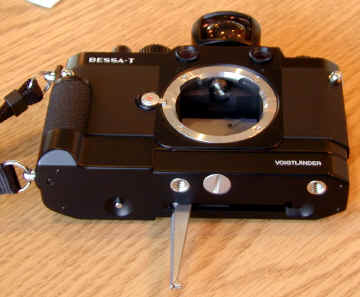
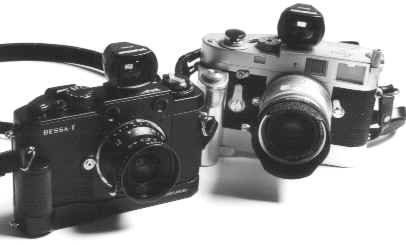

Re-think your way of thinking about
Rangefinders: This is a VERY different design.
The new M mount Bessa T has a very different, retro design.
Instead of a combined rangefinder - viewfinder, it uses separate accessory
shoe mounted viewfinders with a separate rangefinder of long effective baselength
built into the body. Why use separate rangefinder
- viewfinders ? To fill a niche in the M rangefinder market -- the ENTRY Level
M market. This is the lowest priced M mount camera made today.
The silver or black body sells for $450, the optional black trigger
winder sells for $175. While the super
wide 12, 15, and 25 Voigtlander wides include the finder with the lens, the
accessory Voigtlander 28, 35, 50, 75, 90 viewfinders sell separately between $125 to
$150 each. Another route is using any of the many classic variable 35-135
finders. If accessory finders are new to you, visit Accessory
Finders. The Bessa T's shown on this page are all prototypes.
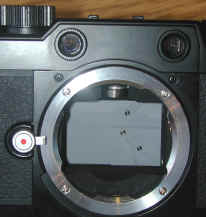
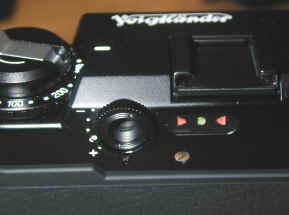
M Mount ?
Yes, Leica M bayonet mount. You can use
most M mount lenses (by Leica or Konica or
anyone else), or any Leica Screw mount lens with a screw mount to M bayonet mount adapter.
If this is new to you, visit the Screw Mount to Bayonet
Adapter page. Unlike Leica M's, it makes no difference which of the three
possible adapters you use, since the Bessa T has no built in viewfinder to couple them to.
Will Voigtlander make M mount lenses ? NO. See the
special Copal shutter with a 2nd outer shutter to make sure the metal blades are light
tight.
The factory trigger winder is also interesting.
The T is the only M Mount camera in production with an
optional factory bottom winder. I know for a fact that Cosina's
CEO Mr. Kobayashi is a fan of Tom Abrahamsson's
Rapidwinder, a detachable fast trigger wind advance which doesn't
need batteries -- it uses finger power.
Unlike the Leicavits or Rapidwinders, the Bessa T's trigger winder can be added or
removed at any time without exposing the film.
inexpensive camera,
big rangefinder
Selling at about 1/20 the cost of a
new Leica M,
yet focusing more accurately than any Leica M except the .85, the Bessa T has a
unique place in M mounts. Its price range has all the initial markings
of a lightweight, just like the inexpensive Leica CL of the '70s. Yet, the
Bessa T has killer instinct. Unlike the CL, the Bessa T has a long effective
baselength rangefinder. For the 1st time ever, an inexpensive M camera
can accurately focus even the super fast 50/1 Noctilux, the 75/1.4 Summilux, or
135/3.4! Voigtlander's inexpensive Bessa T is alone in the entry level
M market. I wonder if Leica will answer the call -- with Leica's high labor
costs, I wonder if they can.
Tom Abrahamsson on the Bessa T:
Bessa-T - At last!
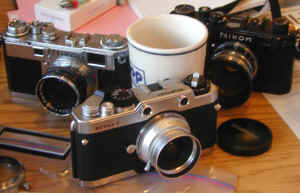 Now I can "spill the beans" about the Bessa-T. It is a
non-viewfinder, but rangefinder equipped Bessa body with an M-lens mount. Think about it a
bit! You have to focus through a small window at the back, move your eye to the viewfinder
for the lens you are using for framing and then shoot. Initially I was skeptical when I
saw the camera last year in Japan. I have a very bad
Now I can "spill the beans" about the Bessa-T. It is a
non-viewfinder, but rangefinder equipped Bessa body with an M-lens mount. Think about it a
bit! You have to focus through a small window at the back, move your eye to the viewfinder
for the lens you are using for framing and then shoot. Initially I was skeptical when I
saw the camera last year in Japan. I have a very bad
track record with external viewfinders - most of them are lost, broken or small pieces of
essential glass fall out of them. When they work, they are great. Bright and contrasty as
well as rather pricey and bulky. Like most of you have kept some of them around for years,
not knowing why, but at last I have found a use for them. The Bessa-T is weird, no two
ways about it, but in some strange way, it works! I have had one now for a couple of weeks
and put about 25 rolls through it. Lenses have varied from 21mm to 75mm focal length and
when I find my 90mm finder, I will try out that one too. With the lenses up and including
35. I use the camera as a hyperfocal camera with a "focus" checker built in. Now
and then I would check that my range was within the focus and occasionally I would
fine-tune using the cameras rangefinder. One can shoot fast and furious that way and have
a reasonable rate of success. With lenses longer than 35 (or 35 in very low light) it is a
slower process. You carefully focus and then move the eye to the finder and frame. It
sounds a bit clumsy and for anyone weaned on M rangefinders, it takes a while to get used
to. (the exquisite threesome above is Tom's black Nikon S mounting a prototype
Voigtlander SC Skopar, my chrome Nikon S2, and a prototype Voigtlander Bessa T mounting a
prototype Voigtlander 21/4)
What really helps is the quality of the rangefinder. It is very bright and
contrasty, the focus snaps in and out very quickly and precisely. There is a diopter
control on the ocular - seems to handle at least +2 to -1 diopters correction. I found
that with the 21 and 24 I shot similar to a Bessa-L, you wave the camera in the general
direction and shot with less concern for precise framing. The focus was a nice feature
when shooting wide-open, even a wide-angle lens will show focus loss when shot wide open
without precise focusing. Where the Bessa-T shines is with the 35/1,4, the fast 50's and
the 75/1,4. The base of the rangefinder is about 38 mm and the magnification is 1,5 so the
baseline is 58mm, more than enough to give you precise focus even with a 75/1,4 wide-open.
My 75 is a fairly late one with the built in hood and I could notice a slight shadow in
the rangefinder when focusing close from the hood intruding. Not enough to make it
useless, just something one had to think about. The trick was to push the hood back
for focus and pull it out for shooting. Clumsy, maybe but it worked and that is the
key. The 75 is not an easy lens to focus on the M6, but with the Bessa-T it was a
"snap". The "tunnel" vision that you get with the rangefinder (those
who use screw-mount Leicas know what I am talking about) forces you to be very precise
with the focus and "lock" it in. Yes, it is slower than with an M, but for
portraits, I think it would work very well.
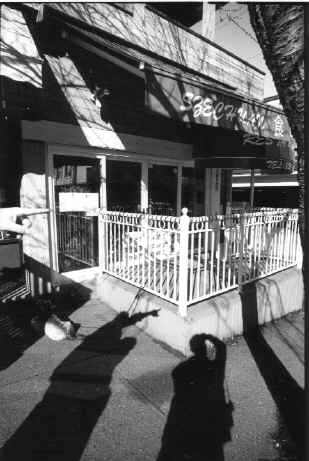 The meter is the same as
in the Bessa-L or R and the readout is on the back of the camera. You can see the
diodes (red-green-red) when you focus or frame the shot and correct quickly. The
meter works very well (it rivals the M6 meter for precise reading and uses far less
batteries), but as you have no idea what the coverage is, you have to be careful with
strong light sources throwing it off, particularly with wider lenses.
The meter is the same as
in the Bessa-L or R and the readout is on the back of the camera. You can see the
diodes (red-green-red) when you focus or frame the shot and correct quickly. The
meter works very well (it rivals the M6 meter for precise reading and uses far less
batteries), but as you have no idea what the coverage is, you have to be careful with
strong light sources throwing it off, particularly with wider lenses.
Another feature that is close to my heart is the Voigtl�nder Rapidwinder!
Yes, I now have competition at last. It is a very slick unit that can be attached
and removed from the camera (although why anyone would want to remove it I can't
understand) without fogging film. It is smaller and lighter than mine, it has a small,
shallow grip with 2 strap lugs attached so that you can carry the camera vertically (a la
M5!). The lever is longish and 'flops" down and locks in place. The
"unlock" mechanism is neat, you just push the lever backwards about 30 degrees
and it frees it and you can fold it up. Good idea, but the main problem is that if you
push it by mistake, it has to be folded up and then down again to lock. It feels flimsier
than mine, but mine might be a case of overkill. The action is smooth, but it has more
inertia than the Rapidwinder and a tendency to "high-spot" about halfway through
the cycle. It is an almost essential piece of equipment as the eye of the shooter is more
centered on the Bessa-T with the top-mounted viewfinder and there is precious little room
for the finger to pull on the top-mounted advance lever. Even a right eye focusser is a
bit squeezed there.
The house shot and runner were taken with the 21/4.
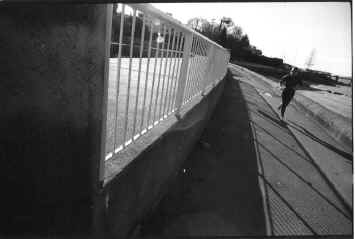 The M-mount worked very smoothly and any of my M-lenses went on without
problems with the lens-lock or focusing roller.
The M-mount worked very smoothly and any of my M-lenses went on without
problems with the lens-lock or focusing roller.
The whole construction of the Bessa-T feels much more solid than the Bessa-R or L. The
rubber cover has a changed texture that makes it less slippery and the controls are
somehow tighter and more positive. The advance lever on the top is now black and has a
ratcheted clutch in it, so that you can do multistroke advance (also possible with the
trigger winder on the bottom).
I am not sure where the Bessa-T fits in the rangefinder camera firmament, but however
weird it sounds, it actually works very well. I can see it being used for wider lenses as
a substitute M camera, but I think it will really come in to play for very tight precise
focusing with high speed lenses, particularly when shooting wide open. Next experiment
will be with the Noctilux at close range at f1!
Voigtl�nder also supplied me with a 21/4 and the 28/1,9 Aspheric. I had
seen both of these lenses at various times before. The 21/4 is in the same mount as the
25/4 Snap-Shot Skopar, a truly small and pocketable 21! It couples to the rangefinder and
so far it has proven it self a very competent lens. I have not had time to shoot
extensively with it, but from the negs, it looks sharp right across the board. Once I have
had a chance to print something from this lens, I will let you know. The price is
evidently going to be around $500 including the finder (which is much better than the
Leica 21 finder!). The 28/1,9 Aspheric looks gorgeous, it looks and feels like a Leica
lens! It is not a small lens, roughly the same size as a Summicron 28/2, but with a much
smarter hood. It does not protrude into the finder of the M-camera as much as the 28/2
hood. Performance again, so far so good, but I need to print stuff shot with it to really
judge it. Mine is a chrome version and it really looks slick on a chrome M2 and balances
well with a M2/Rapidwinder combination.
 Boy, I think Voigtl�nder has done
it again. The Bessa-T is strange, but in a good way, the 21/4 is truly a lens you can
stick in a pocket and carry everywhere and I suspect that the performance of the 28/1.9
not going to be inferior to the 28/2 and most likely at a price that makes it highly
competitive. To my knowledge, my Bessa-T is the first production example in North
America. For those who are serial number nuts, it is 000001 (and the 21/4 is 000006) so
obviously very early production samples. Now we all know about the Bessa-T, the 21 and the
28. I wonder what's next from Cosina/Voigtl�nder.
Boy, I think Voigtl�nder has done
it again. The Bessa-T is strange, but in a good way, the 21/4 is truly a lens you can
stick in a pocket and carry everywhere and I suspect that the performance of the 28/1.9
not going to be inferior to the 28/2 and most likely at a price that makes it highly
competitive. To my knowledge, my Bessa-T is the first production example in North
America. For those who are serial number nuts, it is 000001 (and the 21/4 is 000006) so
obviously very early production samples. Now we all know about the Bessa-T, the 21 and the
28. I wonder what's next from Cosina/Voigtl�nder.
Caddie shot taken with 28/1.9 on M2
Ed: Tom's Pics with the 21 and 28 are used here to illustrate
the story, not to show what the lenses are really capable of, since no computer screen
will do that anyway. However, considering he is an experienced photo
journalist and is very happy with the results, the news is indeed good so far.
Tom Abrahamsson 3/31/01
Follow-up Report
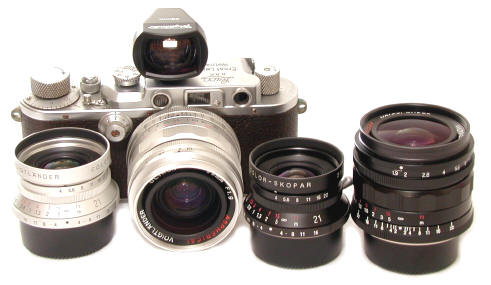
Leica III, Voigtlander 21/4 and 28/1.9's, brightline finder
I have now had a month to use the Bessa-T and the 28/1,9 Ultron and the
21/4 Color-Skopar. The initial novelty has worn off and it is now time to put down
some longer-term emotions about the camera and lenses. The Bessa-T is a somewhat
idiosyncratic camera. The lack of a viewfinder was something that I thought would
irritate me, but to a great extent, it is a
non-issue. The availability of external finders and the quality of these finders is such
that it is a pleasure to shoot with them (be it Leica or Cosina/Voigtlander finders), when
it is convenient to do so. There are times when you wish for an integrated
viewfinder/rangefinder, particularly with longer lenses and in fast shooting situations.
The camera is more comfortable than the Bessa-R insofar that it feels more solid. I have
not taken it apart, but from pure tactile feel, the top-plate is now cast alloy and this
"deadens" the shutter sound somewhat. It is still noisier than an M, but part of
that is the shutter-system with the double curtain (the first curtain is a light baffle as
well as the metering surface, the second is the actual shutter). The higher flash synch
(1/125) and top-speed (1/2000) necessitates a metal shutter. The film advance arm is now
ratcheted and will no longer stick out when you get to the end of the film (as is does on
the Bessa-L and R) and, yes it is
black on the black camera! The back door has a more solid feel to it too. I do not know if
it has a different material or a heavier base than the Bessa-R/L door. It feels more solid
anyway.
The M-bayonet is right on the button. No excessive force is needed to mount M-lenses
and the lock clicks in with a positive feel. I tried it with about 20 different lenses and
so far all have mounted true and coupled to the rangefinder. Just like the Bessa-R/L, if
you use the collapsible 50/90 mm lenses, you can't push the lens all the way in. It stops
about �" from the fully collapsed position as there is a ledge at the back of the
shutter "crate" that interferes. It does clear the sensor for the meter though.
The Russar 20/5,6 cant be used on the Bessas either as the rear element protrudes deep
enough to catch on the same ledge. The lens will mount, but you cannot focus to infinity
as the barrel jams against the ledge. Too bad as it would be a nifty lens to use on the
Bessa-L! The meter is the same as the VC-meter, the Bessa-R and L and one can only
state that it works flawlessly. I suspect that the M6 TTL is slightly more sensitive in
the extreme low light, but on the Best's the batteries are more likely to be still OK.
The Bessa-T's trigger-winder is convenient (but I am biased to
triggerwinders) and it has started to smooth out with use. There is still a bit of inertia
when you start the stroke, but the "high" spot � way through the cycle has
vanished. The lever lock down mechanism is cute, but suffers from being too easy to
disengage. Small and light anyway and the fact that you can attach the strap on a vertical
mode is a benefit.
Conclusion is that the Bessa-T is a good back-up to a M camera and at US$
450, it is cheap enough to dedicate a body to a lens, a 21,24 or 28 with finder will suit
fine. Quality feels higher than the Bessa-L or R and the rangefinder is very good, bright
and contrasty with a good diopter control. For street shooting, I would add the
Trigger-winder (but then I would, wouldn't I?). It is still cheaper than a used CL and I
feel that the T is a better deal. Long base rangefinder, better meter and feels more
solid. The 1/125 flash synch is another advantage - stick one of the Voigtlander double
shoes on the top and run the sensor from the flash in one shoe and the finder in the
other. No, it is not a TTL camera, standard flash synch contact on the left side of the
camera.
I have tried the Bessa-T with lenses from 21mm to 75mm focal length (still
have not found my 90mm finder!) and speeds ranging from f4 to the Noctilux at f1 and the
Summilux at 1,4. Only fuzzy shots have been through my own mistake. The rangefinder works
very well, even shooting the Noctilux at f1 and at 4 feet was fine. The 75/1,4 did show
some mis-focus at extreme close-up, but that could have been my doing. It was a bit of a
hit and miss. At 1.5meter, it was dead on, but at closest focus, there was a small shift.
Using the longer lenses (50mm and more) is a bit cumbersome. You need to frame in the
top-finder, go to rangefinder for focus and then back to top-finder. It is slower
but if you are in no hurry, it works well. The
advantage is that you are using the larger magnification of the external
finders and framing is more effective.
The best lenses for the Bessa-T are the wider ones. The 24/2,8 ASPH
usually lingers in my bag with little or no use. It has gotten a new lease on life with
the Bessa-T. Even the 28 focal length is highly manageable and the 21 is of course a
breeze as it has lots of depth of field to play with. I did a couple of rolls with the
35/1,4 ASPH and the T. It was great street shooting package. You can set hyperfocal and
fine-tune it with the rangefinder and even shoot without looking through the external
finder. The 35mm is an easy focal length to estimate coverage on anyway.
For those who wondered, the Noctilux will not block the rangefinder. You can vaguely see
the barrel of the lens in the lower left of the rangefinder, but not enough to throw it
out. My Noctilux is a late one with the collapsible hood (which is less blocking than the
old style) so old style Nocti's might have a problem. I tried my 60/1,2 Hexanon on the
Bessa-T. That lens and hood
did block the rangefinder.
The 28/1,9 Ultron. Very good lens! I have shot a fair bit of 100 ASA black and white with
it over the last couple of weeks. Contrast is good, slightly lower than the Summicron
28/2, but not enough of a difference to worry about. It works out to about � grade in the
multigrade pack on the enlarger. Center sharpness wide-open is remarkable, at least equal
to the 28/2. The Summicron is crisper in the corners wide-open (it takes a 15-20 times
magnifier to see, not a big deal). Once you hit f2,8 there is no visible difference
between the two lenses! I don't have a 28/2 here, but I have 5-6 rolls that I shot in
Germany last September with it, bright sun and Delta 100 so I caught the sun here and
shoot similar subjects again with 100 ASA film. Not scientific, but close enough for me.
The hood on the Ultron 28/1,9 blocks the viewfinder significantly less than the hood on
the 28/2. Particularly when used on the M6TTL 0,58. The Ultron also has a small,
drop-shaped focus-lever that screws into the barrel. Makes it easy to scale focus for
quick stuff. Conclusion, with approximately $1400 difference in the price (Ultron 28/1,9
$550 and Summicron 28/2 at $ 1950) it is a no-brainer in my book! $1400 buys another
M6 body used or a rather large volume of film instead!
The 21/4 Color-Skopar. The all time bargain lens by Voigtlander. At $ 375 with the finder,
it is a jewel. It is small, same barrel as the 25/4 Snap-Shot Skopar and lightweight. It
does couple to the rangefinder on the LTM or M camera. It has a similar focus lever as the
28/1,9. The brightline finder is as good as the Leica 21 finder (almost the same price as
the 21/4+ its finder!). Optical quality is very good. If you have used the 25/4 Skopar,
you will recognize the quality. Sharp and contrasty with a remarkable lack of fall-
off in the edges. Just from looking at the negs, less fall-off than the 21/3,4 has. It has
now found a permanent home in my camera bag. It is small enough that you can stick the
lens/finder combo in the pocket and have a really wide lens available, without the burden
of a 21/2,8. It is not a 21/2,8 Aspherical, but it probably comes within spitting distance
at about 1/6 of the cost. It has an another advantage, it is a lens that you probably will
leave in the pocket of your jacket or in your bag. This means that rather than going
"Boy, do I wish I had a 21 here now" - you now have one along. The 21/2,8 ASPH
is not a lens that you drag around frivolously - the 21/4 and its finder occupies about
the same space as 2-3 rolls of film! Oh,
remember, you can use the 21/4 on a LTM Leica too!
Testing will continue of all of these products. I saved enough money not
buying the 28/2 and sticking with the 28/1,9 that I have ordered a 0-series Leica. Now
testing that one will be fun!
All the best,
Tom Abrahamsson
B/W Pics Courtesy of Tom Abrahamsson at Rapidwinder.com
The Voigtlander
Bessa T has a special place in Leica M mount camera history.
First of all, the Bessa T is a
unique camera design utilizing a built in
rangefinder without a built in viewfinder. It is the
ONLY Leica M mount camera with a built in
diopter adjustment for the rangefinder. It is the
ONLY Leica M mount camera with a meter readout visible from the top
of the camera, making it ideal for low angle and Visoflex applications.
It is the 1st mechanical shutter Leica M mount
camera not built in cooperation with Leica. It is the
least expensive Leica M mount camera ever made.
It is the first Leica M mount camera made by
Cosina Voigtlander. All in all, not a bad list of achievements for Mr.
K's 1st M!
Prices Voigtlander System
Bessa Chart Bessa
R2A/R3A Bessa R2 Bessa T Heliar 101
101 PICS Bessa T intro
Bessa T T or IIIf? Bessa R
Lenses
35/1.2 21/25
Shade
Accessories VC
Meter II
MiniSoftRelease Bessa
R2S & R2C SC Lens Intro
SC Lenses SL
Lenses SL 12&15 Lenses Prominent 50mm
Lens Adapter
CameraQuest Home
Shopping Cart
Price List
Camera
Articles
I Buy / Wants Repairs Books Adapters
Revised:
September 11, 2017
. Copyright � 2001-2013 Stephen Gandy. All rights reserved. This means you may NOT
copy and re-use the text or the pictures in ANY other internet or printed
publication of ANY kind. Information in this document is subject to change
without notice. Other products and companies referred to herein are
trademarks or registered trademarks of their respective companies or mark
holders.





